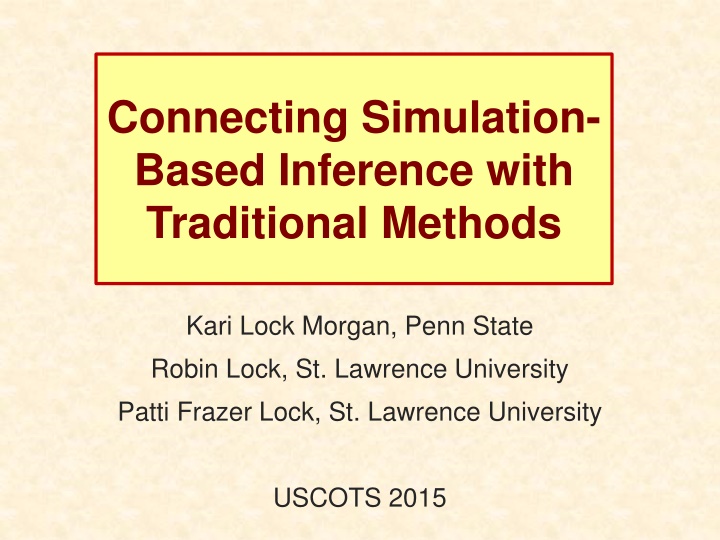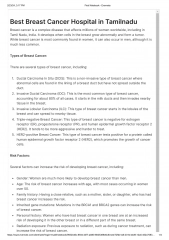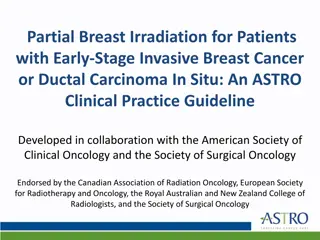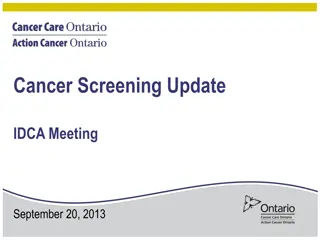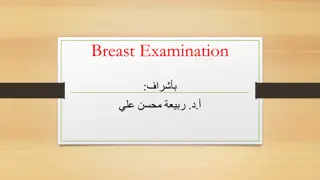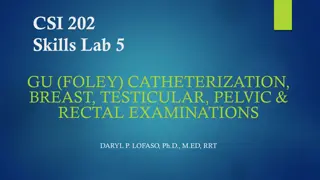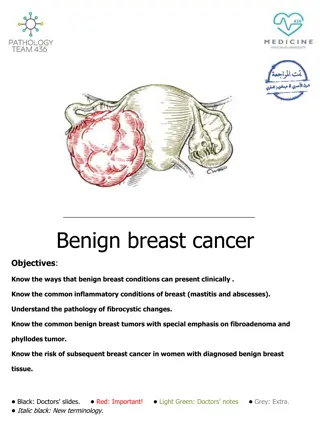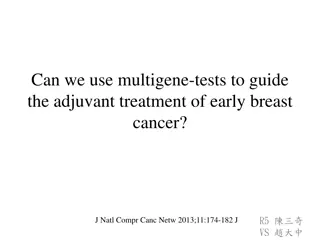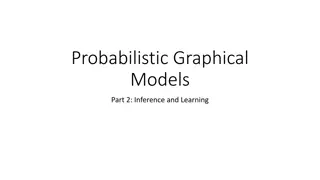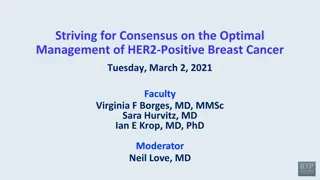Connecting Simulation-Based Inference for Breast Cancer Risk
Using simulation-based and traditional methods to study the impact of hormone replacement therapy on breast cancer risk. Explore statistical transitions and real-world examples to understand the connection between different inference approaches.
Download Presentation

Please find below an Image/Link to download the presentation.
The content on the website is provided AS IS for your information and personal use only. It may not be sold, licensed, or shared on other websites without obtaining consent from the author.If you encounter any issues during the download, it is possible that the publisher has removed the file from their server.
You are allowed to download the files provided on this website for personal or commercial use, subject to the condition that they are used lawfully. All files are the property of their respective owners.
The content on the website is provided AS IS for your information and personal use only. It may not be sold, licensed, or shared on other websites without obtaining consent from the author.
E N D
Presentation Transcript
Connecting Simulation- Based Inference with Traditional Methods Kari Lock Morgan, Penn State Robin Lock, St. Lawrence University Patti Frazer Lock, St. Lawrence University USCOTS 2015
Overview A. We use simulation-based methods to introduce the key ideas of inference B. We still see value in students learning traditional methods How do we connect A to B? (and build more connections along the way)
Three Transitions Distribution: Simulation to Theoretical Statistic: Original to Standardized Standard Error: Simulation to Formula
Outline Example 1: Testing a Difference in Proportions Does hormone replacement therapy cause breast cancer? Example 2: Testing a Proportion Does the coin flip winner have an advantage in NFL overtimes? Example 3: Interval for a Difference in Means How much difference is there in the waggle dance of bees based on the attractiveness of a new nest site? Example 4: Interval for a Mean What s the mean amount of mercury in fish from Florida lakes?
Hormone Replacement Therapy Until a large clinical trial in 2002, hormone replacement therapy (HRT) was commonly prescribed to post-menopausal women In the trial, 8506 women were randomized to take HRT, 8102 to placebo. 166 HRT and 124 placebo women developed invasive breast cancer Does hormone replacement therapy cause increased risk of breast cancer? Rossouw, J. et. al. Risks and Benefits of Estrogen plus Progestin in Healthy Post- Menopausal Women: Principal Results from the Women s Health Initiative Randomization Controlled Trial, Journal of the American Medical Association, 2002, 288(3): 321-333.
Simulation pHRT- pplacebo= 0.0195-0.0153= 0.0042 How unlikely would this be, just by chance, if there were no difference between HRT and placebo regarding invasive breast cancer? Let s simulate to find out! www.lock5stat.com/statkey free online (or offline as a chrome app)
Randomization Test Distribution of statistic if no difference (H0 true) p-value observed statistic
Conclusion If there were no difference between HRT and placebo regarding invasive breast cancer, we would only see differences this extreme about 2% of the time. We have evidence that HRT increases risk of breast cancer This result caused the trial to be terminated early, and changed routine health-care practice for post-menopausal women
Your Turn! NFL Overtimes In the National Football League, a coin flip determines who gets the ball first in overtime. The coin flip winner won 240 out of 428 overtime games ? = 0.561 Test H0:p=0.5 vs. Ha: p>0.5 1. Use StatKey to do this with a randomization test lock5stat.com/statkey
Three Transitions Distribution: Simulation to Theoretical Statistic: Original to Standardized Standard Error: Simulation to Formula
Normal Distribution N(0, 0.002) We can compare the original statistic to this Normal distribution to find the p-value!
p-value from N(null, SE) Same idea as randomization test, just using a smooth curve! p-value observed statistic
Seeing the Connection! Randomization Distribution Normal Distribution
Distribution Transition Many simulated distributions have the same shape; let s take advantage of this! Replace dotplot with overlaid Normal distribution: N(null value, SE) Compare statistic to N(null value, SE) Possible topics to include here: Central Limit Theorem? Sample size requirements? We use this intermediate transition primarily to make connections
Your Turn! NFL Overtimes 2. Normal Approximation Use the normal distribution in StatKey Edit the parameters so that the mean=0.50 (the null value) and standard deviation is the SE from your randomization distribution Find the p-value as the (right tail) area above the original sample proportion (0.561)
Three Transitions Distribution: Simulation to Theoretical Statistic: Original to Standardized Standard Error: Simulation to Formula
Standardization Transition Often, we standardize the statistic to have mean 0 and standard deviation 1 Can connect back to z-scores statistic z =statistic-null null value x mean sd = z SE SE What is the equivalent for the null distribution of the statistic?
Standardized Statistic z =statistic-null SE Hormone Replacement Therapy: From original data: statistic = 0.0042 From null hypothesis: null value = 0 From randomization distribution: SE = 0.002 z =statistic-null SE Compare to N(0,1) to find p-value =0.0042-0 0.002 = 2.1
p-value from N(0,1) Same idea as before, just using a standardized statistic! p-value standardized statistic
Standardized Statistic Standardized test statistic general form: z =statistic-null SE Emphasizing this general form can help students see connections between different parameters Students see the big picture rather than lots of disjoint formulas
Your Turn! NFL Overtimes 3. Standardization Compute ?0 ? ? =????????? ???? ?? from randomization Use StatKey to find the p-value as the area above this z-statistic for a N(0,1) distribution
Three Transitions Distribution: Simulation to Theoretical Statistic: Original to Standardized Standard Error: Simulation to Formula
After standardizing From original data From H0 z =sample statistic- null value SE Compare z to N(0,1) for p-value From randomization distribution Can we find the SE without simulation? YES!!!
Standard Error Formulas Parameter Standard Error ? 1 ? Proportion ? ? ? Mean ?11 ?1 ?1 ?21 ?2 ?2 Diff. in Proportions + 2 2 ?1 ?1 +?2 Diff. in Means ?2
Standard Error Formula Testing a difference in proportions, null assumes p1 = p2, so have to use pooled proportion: p(1- p) n1 + p(1- p) n2 SE = Hormone replacement therapy: 0.017(1-0.017) 8506 +0.017(1-0.017) 8102 SE = = 0.0020
Fully Traditional Now we can compute the standardized statistic using only formulas: z =statistic-null SE =0.0042-0 0.002 = 2.1 p1- p2 ( p 1- p ( n1 )-0 + p 1- p =0.0042 -0 0.002 z = = 2.1 ) ( ) n2 Compare to N(0,1) to find p-value
p-value from N(0,1) Exact same idea as before, just computing SE from formula p-value standardized statistic
Your Turn! NFL Overtimes 4. P-value using standard error via formula Compute the standard error with ?0(1 ?0) ? ?? = Find the z-statistic with ? =????????? ???? ?? Use StatKey to find the p-value as the area above this z-statistic for a N(0,1) distribution
Connecting Parameters All of these ideas work for proportions, difference in proportions, means, difference in means, and more Means are slightly more complicated t-distribution Null hypothesis for a difference in means can assume equal distributions or just equal means
Honeybee Waggle Dance https://www.youtube.com/watch?v=-7ijI-g4jHg Honeybee scouts investigate new home or food source options; the scouts communicate the information to the hive with a waggle dance The dance conveys direction and distance, but does it also convey quality? Scientists took bees to an island with only two possible options for new homes: one of very high quality and one of low quality They kept track of which potential home each scout visited, and the number of waggle dance circuits performed upon return to the hive
Honeybee Waggle Dance Estimate the difference in mean number of circuits, between scouts describing a high quality site and scouts describing a low quality site. ??= 33 ??= 112.42 ??= 93.0 ??= 18 ??= 61.67 ??= 55.7 xH- xL= 50.76
Bootstrap Confidence Interval How much variability is there in sample statistics measuring difference in mean number of circuits? Simulate to find out! We d like to sample repeatedly from the population, but we can t, so we do the next best thing: Bootstrap! www.lock5stat.com/statkey
95% Bootstrap CI 50.76 2 20.6 9.58,91.94 ( ) Chop 2.5% in each tail Chop 2.5% in each tail Keep 95% in middle
Bootstrap CI Version 1 (Statistic 2 SE): Prepares for moving to traditional methods Version 2 (Percentiles): Builds understanding of confidence level Same process applies to lots of parameters.
Your Turn! Florida Lakes Fish were taken from a sample of n=53 Florida lakes to measure mercury levels. Summary: ? = 53 ? = 0.527 ? = 0.341 Find a confidence interval for the mean mercury level in all Florida lakes 1. Bootstrap CI Use StatKey to make a bootstrap distribution and find the CI two ways: Using ? 2 ?? Using the middle 95% of the bootstraps Switch to find a 90% CI Compare
Three Transitions Distribution: Simulation to Theoretical Statistic: Original to Standardized Standard Error: Simulation to Formula
Normal Distribution N(50.76,20.59) ?? ??=50.76
CI from N(statistic, SE) Same idea as the bootstrap, just using a smooth curve!
Seeing the Connection! Bootstrap Distribution Normal Distribution
Your Turn! Florida Lakes 2. Normal Approximation Use the normal distribution in StatKey Edit the parameters so that mean = the original mercury mean std. dev. =SE from your bootstrap distribution Choose Two-tail and adjust the percentage to get the bounds for the middle 90% of this distribution.
Three Transitions Distribution: Simulation to Theoretical Statistic: Original to Standardized Standard Error: Simulation to Formula
Standardization Transition We already have ????????? 2 ?? To get a more precise value and reflect different confidence levels, replace the 2 with a %-tile from a standardized distribution ????????? ? ?? or from N(0,1) ????????? ? ?? from t
Standardized Endpoint For a difference in means with n1=33 and n2=18, use a t-distribution with 18-1=17 d.f. and find t* to give 95% confidence (StatKey) Same idea as the percentile method! ? = 2.110
CI using t* and Bootstrap SE ????????? ? ?? Original ? From t17 From bootstrap 50.76 2.110 20.59 50.76 43.44 = (7.32,94.20) Same idea as the bootstrap standard error method, just replacing 2 with t*!
(Un)-standardization In testing, we go to a standardized statistic In intervals, we find (-t*, t*) for a standardized distribution, and return to the original scale Un-standardization (reverse of z-scores): statistic statistic t* SE t* SE x = mean+t sd What s the equivalent for the distribution of the statistic? (bootstrap distribution)
Your Turn! Florida Lakes 3. t-interval from bootstrap SE Switch to the t-distribution (52 d.f.) in StatKey Use Two-tail to find the upper endpoint (t*) for the middle 90% of the t-distribution Compute the confidence interval using ? ? ?? from randomization
Three Transitions Distribution: Simulation to Theoretical Statistic: Original to Standardized Standard Error: Simulation to Formula
Standard Error Formula For a difference in two means 2 2 ?1 ?1 +?2 ?? = ?2 For Honeybee circuits data 93.02 33 +55.72 18 ?? = = 20.84
